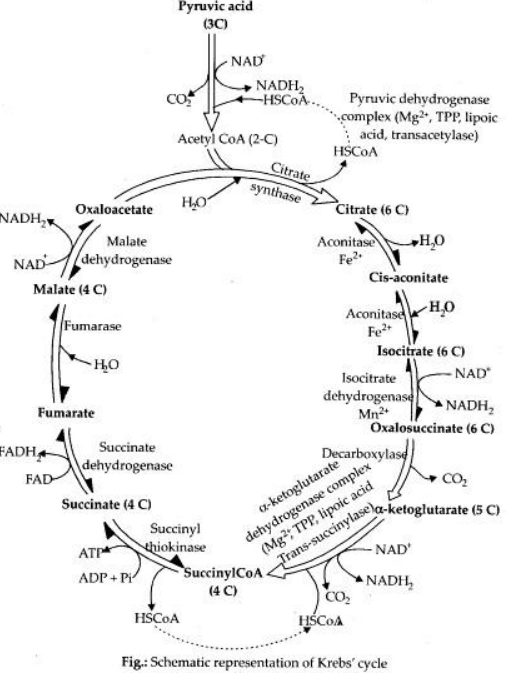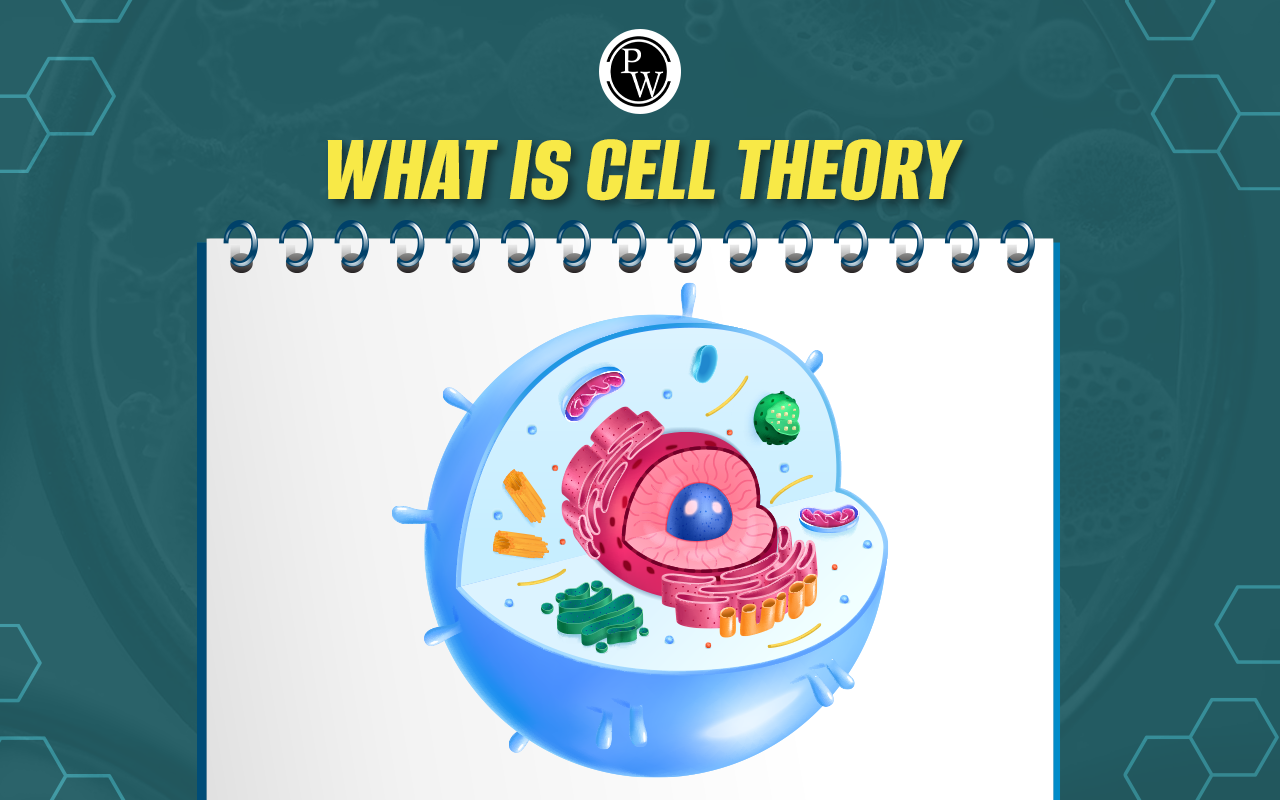
Krebs Cycle: The Krebs cycle, also known as the TCA cycle (tricarboxylic acid cycle) or the Citric acid cycle, is an important series of enzyme-catalyzed reactions that occur in the mitochondrial matrix. In this cycle, acetyl-CoA is oxidized to produce carbon dioxide, while coenzymes are reduced to generate ATP in the electron transport chain.
The cycle is named after Hans Krebs, who proposed the detailed mechanism. It consists of eight steps. In this step, the acetyl group of acetyl-CoA is oxidized to produce two molecules of CO2 and one ATP. Additionally, the process produces the high-energy compounds NADH and FADH2.
Each glucose molecule produces two molecules of acetyl-CoA, necessitating two complete turns of the Krebs cycle. This leads to the formation of four CO2 molecules, six NADH molecules, two FADH2 molecules, and two ATP molecules. This cycle is an important topic for the NEET exam in the chapter Respiration in Plants .
Respiration in Plants MCQ for NEET Biology
Krebs Cycle Diagram
Krebs cycle diagram is as follows:

Krebs Cycle Location
The Krebs cycle, also known as the citric acid cycle or TCA cycle, takes place within a eukaryotic cell's specialized compartment called the mitochondria. The Krebs cycle takes place in specifically in the mitochondrial matrix.
Mitochondria are organelles found in eukaryotic cells. They are known as the "powerhouses of the cell" because they are in charge of cellular respiration, the process by which cells generate energy. The mitochondrial matrix is a gel-like substance that fills the interior of the mitochondria and contains all of the enzymes required for the Krebs cycle to work.
Krebs Cycle Steps
The Krebs cycle, also known as the citric acid cycle, is a series of enzyme-catalyzed reactions that occur in aerobic organisms following glycolysis. These reactions play a crucial role in the further breakdown of pyruvate, a product of glycolysis, to produce energy in the form of ATP. The following is a detailed explanation of the Krebs cycle steps:
1. Formation of Acetyl CoA and CO2:
After glycolysis, pyruvate molecules are carboxylated to form acetyl CoA and CO2.2. Oxidative Decarboxylation of Pyruvate to Acetyl CoA:
- This step links glycolysis to the citric acid cycle.
- Pyruvate is oxidatively decarboxylated to acetyl CoA and CO2.
- This process is catalyzed by the pyruvate dehydrogenase complex, located in the mitochondrial matrix in eukaryotes and in the cytoplasm of prokaryotes.
- Each glucose molecule produces two molecules of pyruvate, each of which forms one acetyl CoA along with one NADH by the end of the pyruvate oxidation.
- Acetyl CoA from pyruvate oxidation, fatty acid metabolism, and the amino acid pathway enter the citric acid cycle.
3. Steps of the Citric Acid Cycle:
The citric acid cycle consists of eight enzyme-catalyzed reactions.
Step 1: Condensation of Acetyl CoA with Oxaloacetate:
- Acetyl CoA combines with oxaloacetate to form citric acid (a six-carbon compound).
Catalyzed by citrate synthase.
⬇️
Step 2: Isomerization of Citrate into Isocitrate:
- Citrate is converted into isocitrate through an intermediate, cis-aconitase.
Catalyzed by aconitase.
⬇️
Step 3: Oxidative Decarboxylation of Isocitrate:
- Isocitrate is oxidatively decarboxylated to form α-ketoglutarate.
Catalyzed by isocitrate dehydrogenase, this step produces NADH and CO2.
⬇️
Step 4: Oxidative Decarboxylation of α-Ketoglutarate:
- α-Ketoglutarate is oxidatively decarboxylated to form succinyl-CoA and CO2.
Catalyzed by α-ketoglutarate dehydrogenase, this step produces NADH.
⬇️
Step 5: Conversion of Succinyl-CoA into Succinate:
- Succinyl-CoA is converted into succinate, producing GTP (which can be converted into ATP).
Catalyzed by succinyl-CoA synthase.
⬇️
Step 6: Dehydration of Succinate to Fumarate:
- Succinate is dehydrogenated to form fumarate, producing FADH2.
Catalyzed by succinate dehydrogenase.
⬇️
Step 7: Hydration of Fumarate to Malate:
- Fumarate is hydrated to form L-malate.
Catalyzed by fumarate hydratase.
⬇️
Step 8: Dehydrogenation of L-Malate to Oxaloacetate:
- L-Malate is dehydrogenated to form oxaloacetate, producing NADH.
Catalyzed by malate dehydrogenase.
- Oxaloacetate formed in the last step allows the cycle to repeat, and NADH produced participates in oxidative phosphorylation to produce ATP.
The entire cycle completes with the formation of oxaloacetate, ready to start the next cycle.
This cycle plays a crucial role in the production of energy in the form of ATP in aerobic organisms.
Krebs Cycle Products
The Krebs cycle products are as follows:
1. First Turn of the Citric Acid Cycle:Products: One GTP (or ATP), three NADH, one FADH2, and two CO2.
2. Requirement for Glucose Molecule:- Two acetyl-CoA molecules are produced from each glucose molecule.
- Two cycles are needed per glucose molecule.
Products after two cycles: Two GTP, six NADH, two FADH2, and four CO2.
3. Overall Reactions in the Citric Acid Cycle:Acetyl-CoA + 3NAD + + FAD + GDP + P i + 2H2O → CoA-SH + 3NADH + FADH 2 + 3H + + GTP + 2CO 2
4. Overall Pyruvate Oxidation Reaction:Pyruvate ion + 4 NAD + + FAD + GDP + P i + 2 H 2 O → 4 NADH + FADH 2 + 4H + + GTP + 3CO 2 .
5. Overall Glucose Oxidation Reaction (excluding reactions in the respiratory chain): Glucose + 10 NAD + + 2 FAD + 2 ADP + 2 GDP + 4 P i + 2 H 2 O → 10 NADH + 2 FADH 2 + 10 H + + 2 ATP + 2 GTP + 6 CO 2 . 6. Balanced Reactions:Assuming P i represents the H2PO4− ion, ADP, and GDP the ADP 2− and GDP 2− ions, respectively, and ATP and GTP the ATP 3− and GTP 3− ions, respectively.
7. Total ATP Yield:Estimated to be between 30 and 38 ATP molecules after complete oxidation of one glucose in glycolysis, citric acid cycle, and oxidative phosphorylation.
| Other NEET Biology Topics | ||
|---|---|---|
| Ribosomes | Pollination | Apomixis |
| Centrosome | Embryo | Tissues |
Krebs Cycle and Glycolysis
Krebs Cycle and Glycolysis are both fundamental metabolic pathways involved in cellular respiration, the process by which cells extract energy from food molecules. Despite their shared role in energy production, these pathways differ in their location, substrates, and overall ATP yield.
Glycolysis :
- Occurs in the cytoplasm.
- Breaks down glucose into pyruvate.
- Produces four ATP molecules per glucose molecule.
- Serves as the initial step in cellular respiration.
Krebs Cycle:
- Krebs cycle takes place in the mitochondria.
- Converts pyruvate into water and carbon dioxide.
- Yields two ATP and GTP molecules per acetyl CoA (derived from pyruvate).
- Also known as the citric acid cycle or tricarboxylic acid cycle.
- An aerobic process that oxidizes fatty acids and generates more ATP compared to glycolysis.
Acetyl CoA as the Link:
Acetyl CoA acts as the bridge between glycolysis and the Krebs cycle.
Pyruvate dehydrogenase converts pyruvate from glycolysis into acetyl CoA, which enters the Krebs cycle for further energy extraction.
In conclusion, while both glycolysis and the Krebs cycle contribute to cellular energy production, they operate in different cellular compartments, use different substrates, and produce varying amounts of ATP, with the Krebs cycle being more efficient due to its ability to oxidize fatty acids.
Significance of Krebs Cycle
The Krebs cycle, also known as the Citric Acid Cycle, is a vital pathway in cellular metabolism that completes the oxidation of glucose, fats, and amino acids. Here's a structured explanation of its significance:
- Diverse Nutrient Utilization: The Krebs cycle is the final step in the oxidation of various nutrients besides glucose, including fats and amino acids.
- Amino Acid Metabolism: Amino acids, the metabolic products of proteins, are deaminated and converted into pyruvate and other intermediates of the Krebs cycle. Examples include alanine converting to pyruvate, glutamate to α-ketoglutarate, and aspartate to oxaloacetate upon deamination.
- Fatty Acid Oxidation: Fatty acids undergo β-oxidation to form acetyl CoA, which then enters the Krebs cycle for further metabolism.
- ATP Production: The Krebs cycle is a major source of ATP production in cells, generating a significant amount of energy through the complete oxidation of nutrients.
- Role in Biosynthesis: The cycle plays a crucial role in gluconeogenesis, lipogenesis, and the interconversion of amino acids. Intermediate compounds from the cycle are used in the synthesis of amino acids, cytochromes, nucleotides, and chlorophylls.
- Vitamin Dependence: Vitamins such as riboflavin, niacin, thiamine, and pantothenic acid are essential for the Krebs cycle, acting as cofactors and coenzymes in various enzyme reactions.
- Regulation: The regulation of the Krebs cycle depends on the supply of NAD+ and the utilization of ATP for physical and chemical work.
- Genetic Defects: Genetic defects in enzymes of the Krebs cycle are associated with neural damage, highlighting the importance of proper functioning of these enzymes.
- Liver Function: The liver plays a significant role in the Krebs cycle, and liver cell damage can have severe consequences. Liver diseases can lead to hyperammonemia, resulting in reduced ATP generation and potentially causing convulsions and coma.
The Krebs cycle is a fundamental process in cellular metabolism, providing energy and intermediates for various biochemical pathways essential for life.
PW offers the Online Coaching for NEET Aspirants. Participate in interactive live sessions led by experienced educators who rapidly break down complex concepts into easily understandable modules. Get free access to real-time guidance, resources, and study materials for the NEET exam.
| NEET Exam Important Links | |
|---|---|
| NEET Biology Syllabus | NEET Biology Diagrams |
| NEET Biology MCQ | NEET Biology Chapter wise Weightage |
| NEET Exam Notes | NEET Previous Year Question papers |
Krebs Cycle FAQs
What is the Krebs Cycle?
What are three sources of ATP?
Where is ATP stored?
Why is it called the Krebs Cycle?
How is food converted to ATP?
Why is ATP required for glycolysis?










